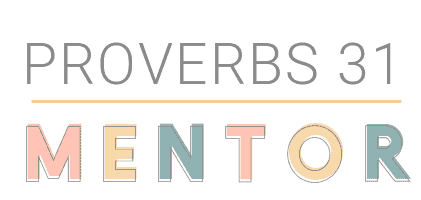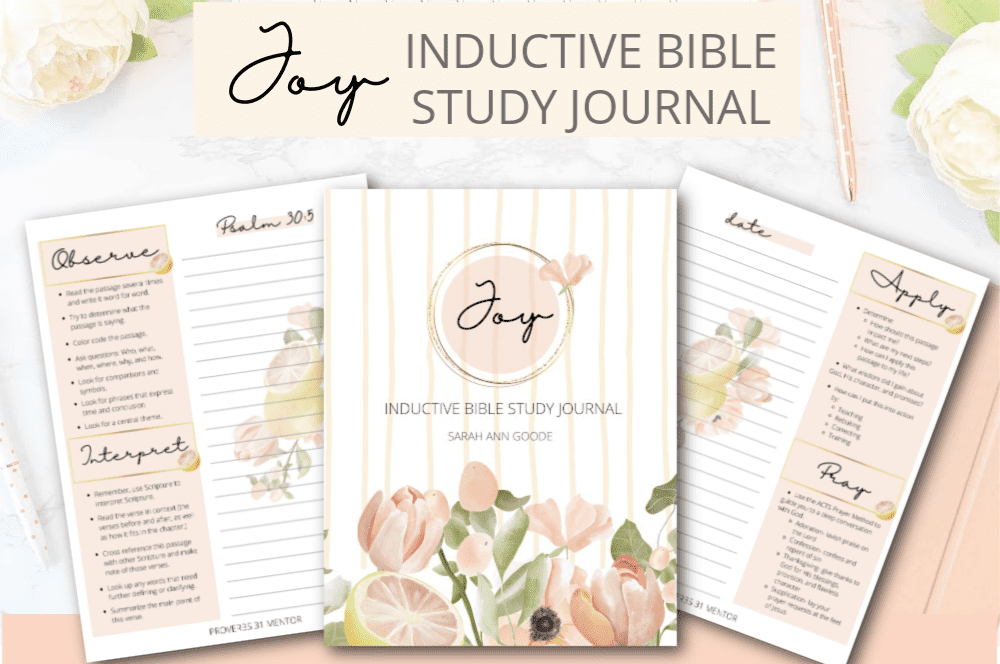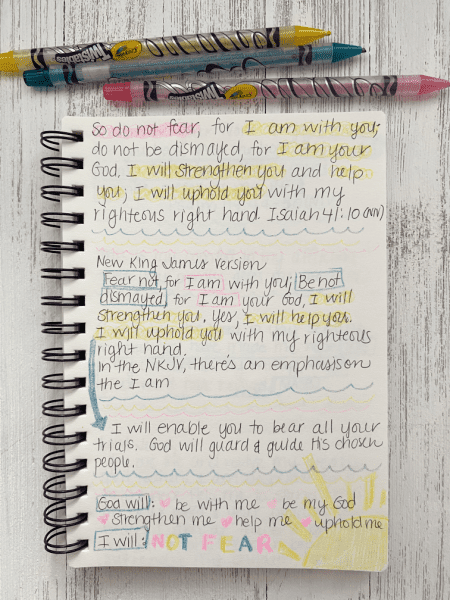How to Do an Inductive Bible Study to Understand the Bible
Are you ready to ignite a passion for God’s Word deep in your soul by learning a meaningful way to study the Bible? This ultimate guide to the Inductive Bible Study method will help you study the Bible with confidence and help you see the big picture of God’s Holy Word. I’ll help you every step of the way, too! (Pinky promise!)
Start growing in faith with the free Spiritual Growth Jump Start Challenge!
Get instant access to these free resources and then continue to grow in faith through our Scripture Sisterhood e-mail community. We never share or sell your data! Visit our privacy policy for more details.
What is the Inductive Bible Study Method and what are the benefits?
While you may have heard the term “Inductive Bible study” before, you may not be familiar with it.
The Inductive Bible Study Method is a systematic way to study the Bible so you can understand the meaning and intent behind a passage or verse.
As a result, you’ll be able to better apply Scripture to your life and be transformed by the Word of God.
There are three main parts to this Bible study method (and you probably have done some or all of these in the past!)
Three steps of inductive Bible study include:
- Observation
- Interpretation
- Application
Then, to take my understanding of Scripture even further, I added journaling, Scripture memory, and prayer to this already powerful study method. (I even added a decorative flair with coloring and journaling elements, too!)
Pin this resource:

Step 1- Observation
The goal of the observation stage is to simply understand what the passage is saying.
FYI, this study method has encouraged me to read Scripture in small, bite-size pieces so I can do a deeper dive into the meaning and it’s been a blessing slowly savor God’s Word.
First, I read the verse or passage several times.
In case you’re wondering, I am currently using the NIV Journal the Word Bible. While I prefer the ESV translation, I couldn’t find one with a large enough print for my poor eye sight!
Then, I write the verse or passage word for word in my journal.
I find this step very beneficial and the act of writing makes information stick in my memory more than just reading it.
Journaling the verse or passage has helped me slow down and pay attention to every word and punctuation mark.
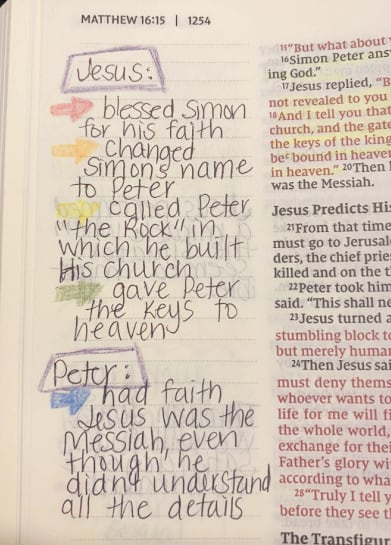
Now comes the fun part of the observation stage- using colored pencils and highlighters!
Since the main goal of the observation stage of an inductive study to figure out what the text is saying, using highlighting and colors helps those details really pop off the page.
As I look at the passage I copied, I look for words describing God, about God, what God has done or will do and mark those with a color (usually yellow).
Then, I look for commands that the children of God need to do and highlight/mark those words with another color (usually pink).
You could even take it a step further by creating a Bible color coding system for other common words and phrases, too. Take a sneak peak how I color code my Bible here.
Then, I’ll use Biblehub.com to compare different translations of the same verse.
This helps me note the different word choices. It’s so enlightening to compare different translations of the Bible!
Another thing I’ll note is when the passage says something in list form. In my illustration below, it lists the things God will do and what I need to do. When you start looking for lists in Scripture, you’ll be amazed at the amount of lists in there!
Ask questions
Start with the basic questions, who, what, when, where, why, and how and make note of those findings in your journal. See this complete list of Bible study questions to help you observe Scripture here.
Look for keywords
As you re-read your passage, look for key words. A key word is an important word to the text that includes repeated words and phrases, synonyms or antonyms of words. Often Scripture will reiterate the same point by repeated or rephrasing important concepts.

Look for comparisons and symbols
Scripture is filled with beautiful words that compare people, things, and places to other objects or people. It’s helpful to note what item is being compared and what it’s being compared to.
For example, Proverbs 4:18 says, “The path of the righteous is like the morning sun, shining ever brighter till the full light of day.” Here, the path of the righteous is being compared to the morning sun.
It may be helpful to mark it with a symbol, such as putting a rectangle around the verse. It doesn’t have to be anything fancy, but it’s a helpful way for Scripture to stand out to you as you read it.
Look for phrases that express time or conclusion
As you read the Bible, it’s important to notice words that express time: before, after, then, during, in the year of …
This helps you note when events take place and start getting an understanding of biblical timeline.
It’s also helpful to note words that show a conclusion, such as the word therefore.
Again, you may want to mark these or denote these with a symbol.
Look for a central theme
As I read, I like to keep a list of the theme of what I read. If I am doing a topical study, I add it to a running list on what I learned about the topic. If I’m doing a chapter study, I’ll see how the theme of this passage or verse fits in with the rest of the chapter.
Step 2: Interpret Scripture
As we begin, it’s important to note that Scripture should be interpreted with Scripture. To do so, you must consider the context surrounding a passage, as well as why it was written and who it was intended for.
Therefore, be careful with studying just one verse without digging deeper. You may miss the true meaning or be tempted to make the verse fit your situation. (Guilty, here!!)
Fun fact: I love to study a small passage or just a few verses at a time! Just be sure you understand how it fits into the bigger picture! To do so, you may need to read the full chapter or surrounding verses to fully grasp the intended message.
As you start to interpret Scripture, pray for wisdom before anything. Ask the Holy Spirit to guide you in understanding and interpreting God’s Word and to open your eyes as you begin to read.
Then, start thinking through:
- Who wrote the text
- Why was it written
- Who it was written to
- What was the culture at the time period and how does it affect the message of the verse
- The verse in context (the verse before and the verse after, as well as the chapter it’s a part of)
Then, it may be helpful to cross reference (dig deeper about what the Bible says about a given topic or note similar passages)
- What do other Scriptures about this topic say? Is this passage consistent with those?
- What does Scripture as a whole say about this topic?
- Where else is this person or topic mentioned in Scripture?
You can use Biblehub.com to quickly look up a cross reference (if you put in a passage you’re looking for, there is a place where it cross references it at the click of a button).
When doing a Topical study, I love to “collect” truths about this topic in one place (see the picture below). It’s easy to see the big picture on the topic I’m studying and then have those verses together in one place!
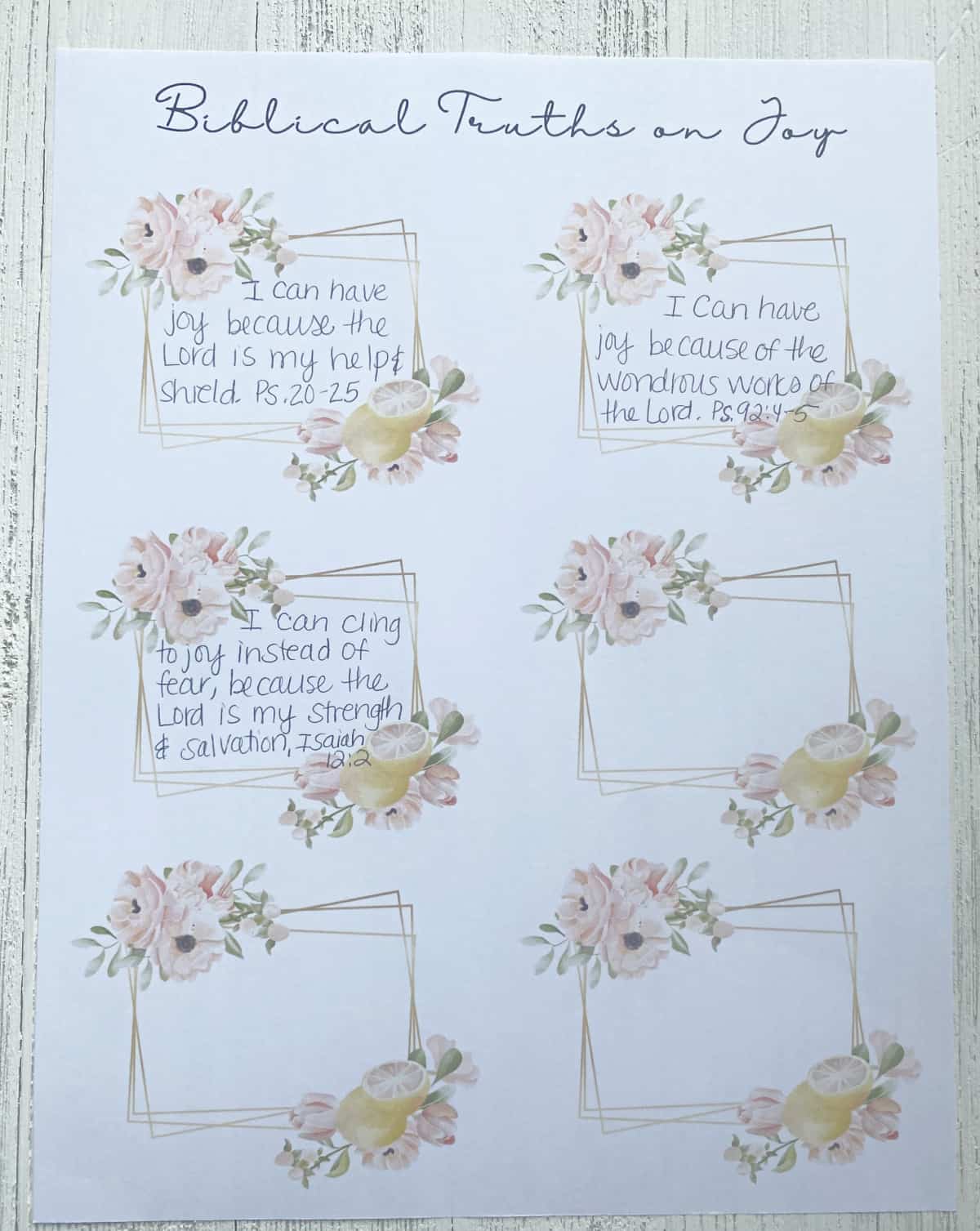
Also, don’t forget to look up the definition to clarify a word or phrase. Biblehub.com again makes that easy to gain further insight into Scripture by researching the Hebrew definition or to see how a word was really intended in Scripture.
Finally, summarize the main point this passage was trying to make. I like to add simple journaling doodles to help this point stand out in my mind, too.
Step 3: Apply Scripture
How Scripture should be used
Before you beginning trying to apply a passage to your life, it’s a must to remember the truth of 2: Timothy 3:16-17.
All Scripture is God-breathed and is useful for teaching, rebuking, correcting and training in righteousness, so that the servant of God may be thoroughly equipped for every good work.
Scripture, all Scripture, was given by God with a purpose, and therefore is useful in our lives.
God’s word is used for:
- Teaching– God gives us biblical wisdom so we can overflow that wisdom and teach it to others. We’re also to live Scripture in our everyday lives.
- Rebuking– When we know what Scripture says, we’re able to determine which areas of our life do not line up with God’s commands. We’re also able to compare our views, thoughts, and actions against the truth of Scripture and adjust our course when we’ve strayed.
- Correcting– Scripture should be used to gently correct and encourage another brother or sister in Christ. We’re to speak God’s truth to other believers to they return to the Lord and press into the Lord for help in a pattern of sin.
- Training– Scripture is to grow us, refine us, and transform us in the image of God. As children of God, we’re to seek the Lord wholeheartedly and over time, God will shape us to be more and more like Him.
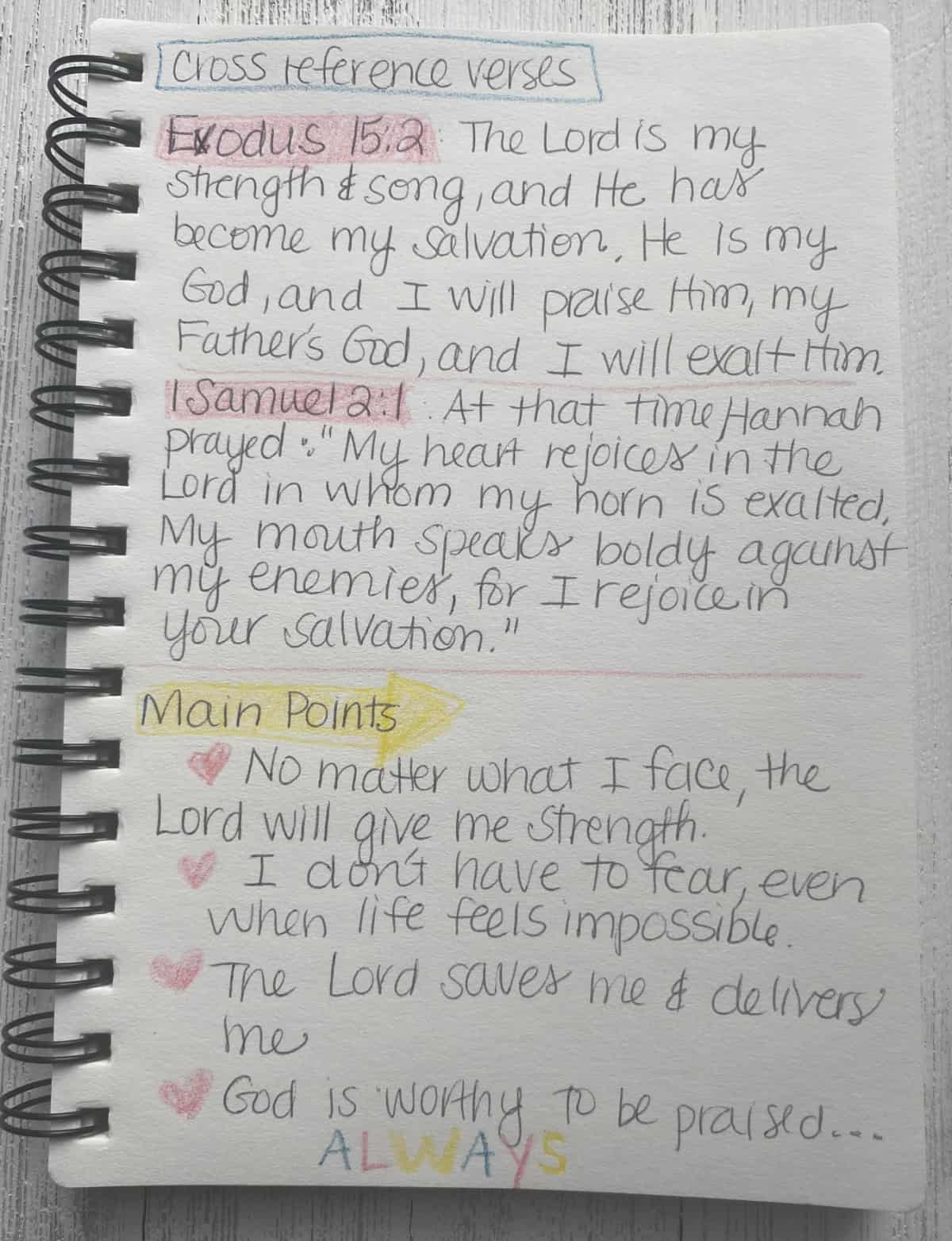
How to Apply Scripture to your life
As you begin applying Scripture to your life, it’s important to keep in mind the Observe and Interpret stages as well.
Taking that information into account, we can logically come to a conclusion about a verse or passage.
Filter your findings through these questions to help you apply a verse or passage:
- How should this passage impact me?
- What are my next steps as a woman of God?
- Is God calling me to change or turn away from something after reading this?
- Who is God calling me to minister to or pray for?
Additions to enhance your Bible study
Journaling for deeper understanding Scripture
Soon after I started Inductive Bible Study, I realized that by adding color and a ‘decorative flair’ to my journal pages, I could visualize the Scripture and reflect on it through the day a whole lot more than with a plain paper and pen.
I started adding Bible journal symbols and designs to my Scripture study and was so surprised at the results.
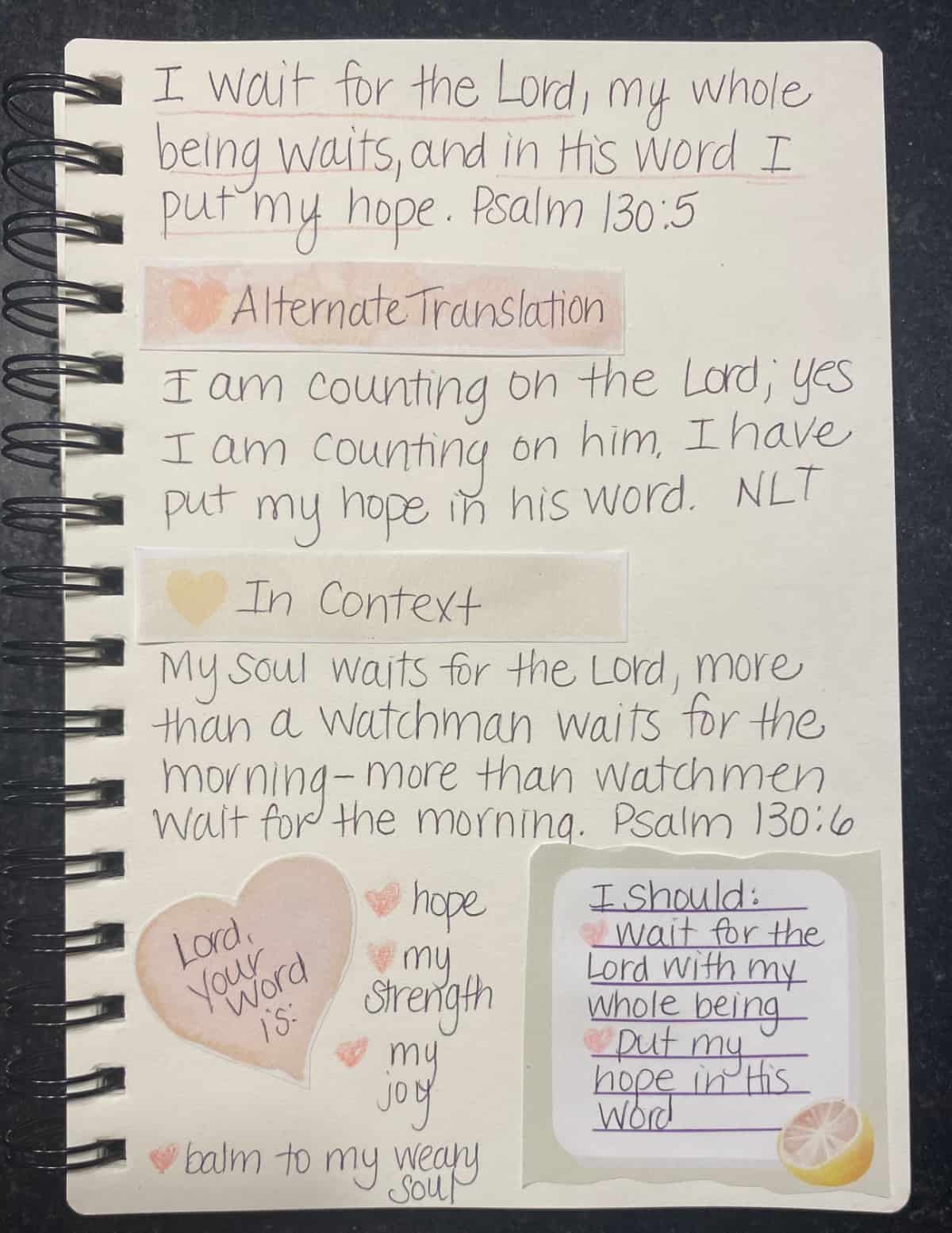
Each day, I walked away with:
- A visual snapshot of God’s Word I could “see” in my mind. Where I typically may not be able to remember what I read, I could pause in stressful moments and remember the journal layout I completed. Then, visualizing the colors and layout, it would bring the verse to mind. It’s been another way to renew my mind with Scripture and help me meditate on the Word.
- A relaxed and peaceful spirit, rooted in the promises of God. When I make the time to sit and savor God’s Word, I walk away refreshed and recharged, ready to take on the day.
- A stronger faith that anchors my soul to the Lord. The more time I sit at the feet of Jesus, the deeper my roots of faith become. (And it’s the same with you!)
Journaling for spiritual growth is a powerful way to meditate on Scripture and saturate your mind with the Word of God. Plus, it’s a practical way to dig deeper in Scripture and get to know the heart of God even more.
Memorizing Scripture
If you’re like me, Scripture memorization doesn’t have the priority in my life that it should. Yet I found it’s a natural extension of an Inductive Bible study method and it makes sense to memorize what I’ve already spent time unpacking.
I find that journaling for Scripture memory is a great and simple way to make this happen.
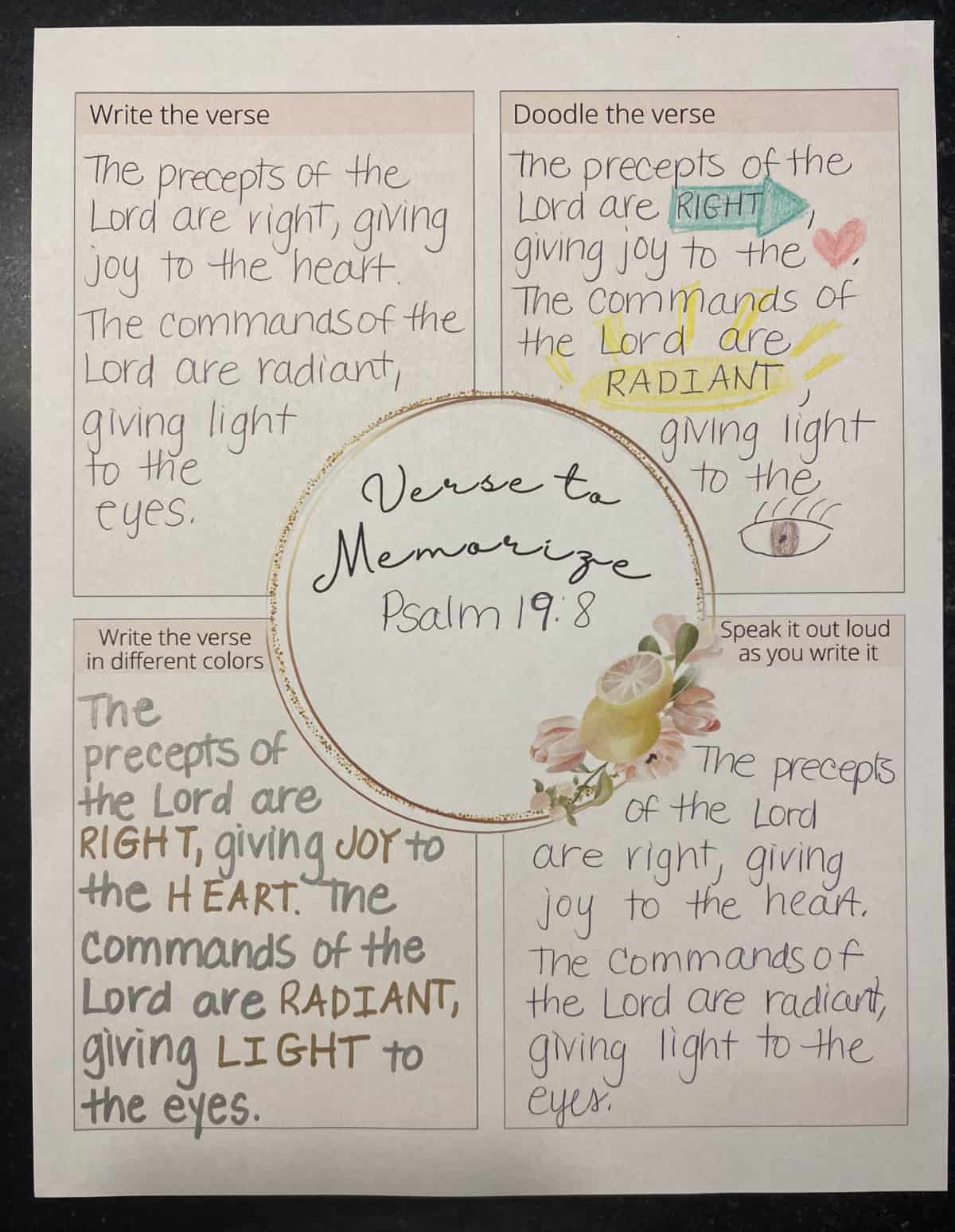
How to memorize Scripture:
- Write the passage– the more you write a verse, the more it will stick.
- Doodle or do a mini-Bible journaling of the verse– I like to try to replace words with symbols as I can, so later I can visualize the doodles and recall the verse a little easier.
- Write the verse in different colors according to emphasized words or phrases.
- Say the verse aloud as you write it– the more that you speak the Word of God, the more you’ll remember it! Saying and writing a Scripture passage is an effective way to remember Scripture.
Prayer
Talking with God is a natural extension of your time in Scripture and a vital part of a healthy quiet time routine.
While there is no certain format or “right way to pray”, it starts with a humble spirit who longs to hear from the Lord.
If you struggle with how to pray, the ACTS Prayer Method is always a simple, but meaningful prayer model.
A- Adoration
Spend time praising God and celebrating the Lord’s faithfulness. He is worth of your praise in good times and in bad!
C- Confession
Confess your sins to the Lord and then repent, turning away from your missteps. Ask the Lord for strength and self-control to help you move past your sin and to find victory from temptation in the name of Jesus.
T- Thanksgiving
Spend time praising the Lord for His blessings and hand in your life.
S- Supplication
Lay your burdens and prayer requests at the feet of Jesus. This is the perfect time to relinquish control of your life and circumstances and rest in the peace of the Lord.
You next steps in Bible study
The Inductive Bible Study is a meaningful study method to help you understand the Bible like never before.
While it may take practice, over time, this may just become your new favorite way to get the most of you quiet time with God.
To help you start studying God’s Word with deeper understanding, the Joy Inductive Bible Study Journal will guide through every step of this powerful Scripture study method.
You’ll experience how to live the joy of the Lord and understand what the Bible has to say about the topic of joy.
Plus, it’s a perfect guide to help you create a meaningful quiet time with God using the Inductive Bible Study Method.
